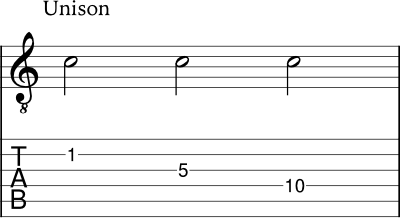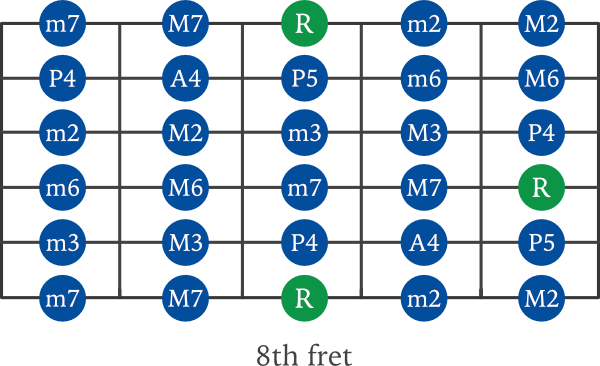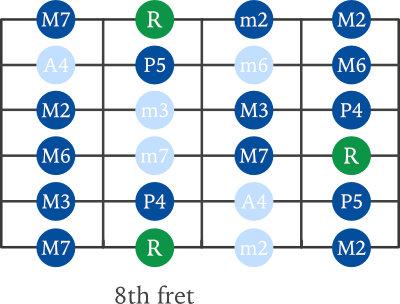In this lesson, we’ll cover what music intervals are and how to play them on the guitar. We’ll include notation examples and guitar charts to help you apply this music theory concept.
In short, learning music intervals help you to:
- Understand how scales and chords are built
- Find notes on the fretboard
- Shift between different keys
- Develop ear training
We’ll first define this term and get into what each music interval is called.
What is an interval in music?
An interval simply means a specific distance between two notes in music. Each distance or “interval” has a particular name that we can use to explain music theory concepts and practical musical application. Let’s look at what each interval is called in the chart below.
Music intervals chart
| Interval name | Abbreviation | Distance in steps | Example |
|---|---|---|---|
| Perfect unison or “unison” | P1 | 0 | C to C |
| minor 2nd | m2 | 1 half step | C to C# |
| Major 2nd | M2 | 2 half steps (1 whole step) | C to D |
| minor 3rd | m3 | 3 half steps (1.5 whole steps) | C to Eb |
| Major 3rd | M3 | 4 half steps (2 whole steps) | C to E |
| Perfect 4th | P4 | 5 half steps (2.5 whole steps) | C to F |
| Augmented 4th or diminished 5th (a.k.a. tritone) | A4 or d5 | 6 half steps (3 whole steps) | C to F# or C to Gb |
| Perfect 5th | P5 | 7 half steps (3.5 whole steps) | C to G |
| minor 6th | m6 | 8 half steps (4 whole steps) | C to Ab |
| Major 6th | M6 | 9 half steps (4.5 whole steps) | C to A |
| minor 7th | m7 | 10 half steps (5 whole steps) | C to Bb |
| Major 7th | M7 | 11 half steps (5.5 whole steps) | C to B |
| Perfect octave or “octave” | P8 | 12 half steps (6 whole steps) | C to C |
Unison interval on guitar
Here are 3 ways to play the same note C note on the guitar. These notes are considered unison intervals because they are in the same register, meaning one location on the staff.

Unison shape examples

minor 2nd interval examples

minor 2nd shapes

minor 2nd variations

minor 2nd variation shapes

The last shape here on the 5th string shape may not be practical if your guitar is not suitable to play past the 12th fret.
Major 2nd interval examples

Major 2nd shapes

Major 2nd variations examples

Major 2nd variation shapes

minor 3rd interval examples

minor 3rd shapes

minor 3rd interval variation examples

minor 3rd variation shapes

Major 3rd interval examples

Major 3rd shapes

Major 3rd interval variation examples

Major 3rd variation shapes

Perfect 4th interval examples

Perfect 4th shapes

Augmented 4th interval examples

Augmented 4th shapes

Perfect 5th interval examples

Perfect 5th shapes

Perfect 5th interval variation examples

Perfect 5th variation shapes

minor 6th interval examples

minor 6th shapes

minor 6th interval variation examples

minor 6th variation shapes

Major 6th interval examples

Major 6th shapes

minor 7th interval examples

minor 7th shapes

Major 7th interval examples

Major 7th shapes

Octave interval examples

Octave shapes

Applying intervals to scales
Once you understand how intervals work, you can create a visual map to identify the relationship between notes. For example, let’s take one position on the fretboard and see what the intervals look like in relation to the root note.
Intervals guitar chart
The following chart shows all of the intervals in one position of the guitar.

By knowing where your intervals are on the fretboard, you can figure out how to play any scale if you know the formula. For example, the Major scale has the following intervals in relation to the root note: Major 2nd, Major 3rd, Perfect 4th, Perfect 5th, Major 6th, and Major 7th.
Major scale on guitar using intervals
In this case, the notes in dark blue circles belong to the Major scale and the notes in light blue are the ones that are omitted.

Using this concept of mapping out intervals will also help you find the notes in triad chords and 7ths chords. This is necessary to know so you can choose the right notes when improvising, regardless of what area you are playing on the fretboard.
For other scale examples, also check out minor scales, pentatonic scales or blues scales.
Compound intervals / chord extensions
Compound intervals are another way to label the distance between notes larger than an octave. For example, a Major 10th interval is basically a Major 3rd placed an octave above. You may often hear some of these intervals referred to as “chord extensions”, “extended chord tones”, or “upper extensions”. These terms are usually used interchangeably.
See the chart below for more examples of compound intervals.
Compound intervals chart
| Interval name | Abbreviation | Distance in steps | Example |
|---|---|---|---|
| Minor 9th | m9 | Half step above octave | C to Db |
| Major 9th | M9 | Whole step above octave | C to D |
| Minor 10th | m10 | 1.5 whole steps above octave | C to Eb |
| Major 10th | M10 | 2 whole steps above octave | C to E |
| Perfect 11th or “11th” | P11 | 2.5 whole steps above octave | C to F |
| Augmented 11th | A11 | 3 whole steps above octave | C to F# |
| Perfect 12th or “12th” | P12 | 3.5 whole steps above octave | C to G |
| minor 13th | m13 | 4 whole steps above octave | C to G# |
| Major 13th | M13 | 4.5 whole steps above octave | C to A |
| minor 14th | m14 | 5 whole steps above octave | C to Bb |
| Major 14th | M14 | 5.5 whole steps above octave | C to B |
| Perfect 15th or double octave | P15 | 6 whole steps above octave | C to C |
What is the difference between scale degrees and intervals?
While intervals refer to the distance between any two notes, scale degrees refer to the distance in relation to the root note. These terms are closed related but have slightly different names to refer to the distance between notes.
Here is a chart to help you understand the relation between intervals and scale degrees.
| Interval | Scale degree |
|---|---|
| Unison | Root |
| minor 2nd | flat 2 or b2 |
| Major 2nd | 2 |
| minor 3rd | flat 3rd or b3 |
| Major 3rd | 3 |
| Perfect 4th | 4 |
| Augmented 4th | sharp 4 or #4 |
| Perfect 5th | 5 |
| minor 6th | flat 6 or b6 |
| Major 6th | 6 |
| minor 7th | flat 7 or b7 |
| Major 7th | 7 |
| minor 9th | flat 9 or b9 |
| Major 9th | 9 |
| Major 11th | 11 |
| Augmented 11th | sharp 11 or #11 |
| Major 13th | 13 |
Another thing worth mentioning is that scale degrees are also synonymous with chord tones to refer to notes in relation to the root note. Chord tones are the notes that determine the quality of a chord. For example, a Major 7 chord has the chord tones 1, 3, 5, and 7. We would say a C Major 7 has the “chord tones” C, E, G, and B.
Wrapping up
Intervals are an important music theory concept to learn because it allows you to understand how scales and chords are built. Once you understand the structure of each interval, you can apply them through your instrument to play ideas throughout the guitar fretboard.
As you start learning to visualize where you intervals are in any given area of the guitar, you’ll get more comfortable at making note choices when playing melodies, improvising, or thinking of chord structures. For an example of this, I recommend this lesson on how to harmonize a melody using 3rds and 6ths.
I hope this information helps you to have a clearer understanding of music intervals and how to apply them on guitar.
If you enjoyed this lesson, you may also want to learn how to build extended chords on guitar.
📘 Get the free guitar practice guide here!
All the best,
JG Music Lessons
Start Playing Better, Faster
by becoming a Pro Member! ✨
Transform your playing by enjoying benefits such as:
• 📙 Exclusive Lesson PDFs and Ebooks
Get access to a growing library of clear, downloadable resources—save time and skip the clutter.
• 🎼 Full Song Lessons
Break down your favorite songs step by step, and play them with confidence.
• 🚫 Ad-Free Learning
Focus better with a distraction-free environment.
• 🎁 Store Discounts
Save 50% off on all song PDFs, charts, audio tracks, bundles, and design printables.
• 💬 Member Support
Got questions? We’ve got your back, helping you stay on track!
👉 Join Here!
Level up with the FREE guitar practice guide and effectively improve your playing! 🎸
Get it sent to your email!



